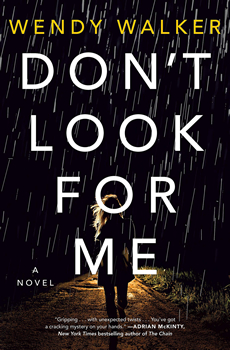

Up Close: Wendy Walker
Tapping into Emotions
 By Dawn Ius
By Dawn Ius
The first chapter of Wendy Walker’s new—and arguably most page-turning—thriller sets the tone with an emotional, hard-hitting depiction of how the life of a mother and wife can quickly spiral downward when a bunch of obstacles are stacked up against one another. It was also inspired by personal experience.
“In fact, it was very close to what happens to Molly in that first chapter,” Walker says. “I was driving home from my son’s soccer game four hours from home. The game had been horrible to witness—rough play, bad ref calls, jeering from the other team’s classmates that was cruel. I felt horrible for my son and realized, perhaps for the first time, that I could not protect my children from many of the uglier things in life.
“On top of that, I was in a difficult stage of my own life, so my emotional base was already compromised.”
Walker says she was at a gas station, unable to stop her spinning thoughts, when she spotted a long road flanked by cornfields and she pondered: What if I just kept walking? Will the pain stop?
Those are the very questions that plague Molly Clark in DON’T LOOK FOR ME. Snubbed by her son, estranged from her daughter, disconnected from her husband. She’s in a vulnerable state when she decides to drive home from her son’s soccer game in a storm—and so when her car is found abandoned at a gas station, her family—along with the police—assume that Molly just…checked out.
Of course, that isn’t the case—just as Walker didn’t keep trudging toward that cornfield, Molly hasn’t actually left her family. At least not voluntarily, no matter how many clues suggest otherwise.
“These types of thoughts, I learned, are very common and come from our primitive flight-or-fight impulses to avoid any kind of pain or fear,” Walker says. “And then I learned that most women who go missing have acted on these thoughts and walked away from their lives. When I finally constructed a story around these themes, I created Molly in a way that most people would understand. I gave her emotional pain that was so severe that the thoughts and actions that follow would provoke empathy and caring and instant attachment to her. This was essential to establish in that first chapter so that readers would turn the page.”
It’s a tactic that works. Walker moves from this gripping first chapter through a story that is classic psychological suspense—there are enough twists and turns to give you whiplash, with the kind of ending that will leave you slack-jawed and wishing you had just one more chapter to read.
In this exclusive interview with The Big Thrill, Walker shares how she delved deep into character, why she is drawn to missing persons, and how setting helps form the chilling suspense that permeates DON’T LOOK FOR ME.
Molly is so relatable—you tapped into so many of her emotions. And given the current situation with the pandemic, families are going through such a strain that this is going to resonate even more, I think. This is first a suspenseful, gripping read—but what message do you hope readers take away when they’ve turned the last page?
I always do a deep dive into psychology when I write. I find that the more real I can make my characters, the stronger the book will resonate with readers. I strive to create suspense, but I also believe that if the reader doesn’t care about the characters, they read simply to solve the mystery and then they forget the book and never think of it again. It’s my goal to make readers feel beyond the last page. Now, more than ever, mothers, and fathers, are suffering emotionally, even if their families have remained healthy. They are feeling what I felt that day—fear and recognition that they can’t protect their children from the world. They are watching their children suffer as their lives are put on hold and their development sidetracked. They have lost pieces of their own lives, maybe going to work or having quiet time to work at home. Seeing friends and extended family for those long conversations that help us sort out our problems. All of these changes, plus the greater concerns about the state of the economy and the world at large, have undermined the foundational security we rely on to go about life every day. Anxiety is at an all-time high. Fight-or-flight instincts are being triggered every day. So I hope readers will take away from DON’T LOOK FOR ME that they are not alone, especially now, but also in the future if they’re ever facing an individual crisis. It’s not only normal—it’s actually built into our brains.
I loved the descriptions of your fictional town of Hastings—you really made the setting come to life. How important is setting to your writing?
Hastings is a fictional town, but very much based on a long stretch of small towns along a river that runs through Connecticut. Many of these towns were once thriving with factories and chemical companies that used the river for transport and waste. As that came to an end, there was nothing left. No major cities nearby. No trains for commuting. Some have survived with tourism, but many look and feel almost dead. Because the road that runs past them is the most direct path to boarding schools and colleges, families who live where I do often find themselves traveling those roads—and at the exact same times. I wanted to move my story out of a wealthy community and into a place that could serve as its own character, and also be the unifying factor that connects the characters who come into play. This is the most heavily I have relied on setting in any of my books, most of which have taken place in and around the wealthier suburbs of Connecticut. It’s very important to the story.
Obviously this a novel of suspense—and on that note it absolutely delivers. But it’s also so much more than that…Does this book feel different, somehow bigger? In what ways did it challenge you as a writer?
I leaned in hard to the emotional aspects of this book. Because it was written in such a page-turning format, I didn’t want the characters to get lost in the plot. I wanted every scene, every passage that wasn’t devoted to delivering information and clues to deliver an emotional charge to the reader. First, from Molly’s story. Then from her daughter, Nicole’s. And then from the way that their guilt over the family tragedy which has shaped them both begins to change as they are placed in these terrifying situations. Guilt plays a major role in the book, as well as grief, and I worked very hard to make those aspects take up as much space on the page as the action.
I love the structure of this book, the way we hear the story through two points of view—Molly and her daughter, Nicole. Both characters are incredibly fleshed out. Was one more difficult to write than the other?
It was so much harder to write Nicole! I rarely feel that way when I have multiple narrations, but Nicole’s chapters had to contain most of the clues and facts and red herrings—all of the technical stuff that is needed to structure a thriller. And yet I was determined to have her character be well-developed and relatable. Every one of her chapters was a careful balance of the two elements. With Molly, the scenes were provocative simply from the events that were unfolding inside that house. Her emotions flowed from those scenes naturally, so I rarely had to go back and add more development. Watching her react in real time, as the horror unfolded, I was able to just write it the way I saw it playing out in my mind.
DON’T LOOK FOR ME is far from a linear story, peppered with all kinds of fantastic twists and turns (that ending though!). I read in an interview that you’re a meticulous plotter. What does that process look like for you?
I do plot every book very carefully. I just can’t move forward unless I know what needs to be disclosed next to make the clues and the facts unfold the way they must. There is also a natural progression of events with each storyline, and I want to stay with that order so that the stories don’t feel unrealistic. I always begin with a list of the facts that need to be disclosed along the way and a list of poignant moments and scenes that will evoke an emotional reaction of some kind (terror, empathy, etc.) and a list of backstory elements that I want to include to develop the characters. From there, I write a chapter outline, and then get input from my editor. Along the way I will always have middle-of-the night revelations that cause me to change things, and also while I’m writing—a tangent will pull me away from the planned plot, and suddenly I have to rewrite things. But starting with a framework gives me the freedom to have those moments of surprise. They are building on the framework, not tearing it down. If the framework is solid, the book will just get bigger and better. For me, if there is no framework, the story can lose its cohesiveness as these new ideas percolate.
DON’T LOOK FOR ME is not your first book with a character that goes “missing”—what attracts you to that theme?
Here’s the bottom line: if the story involves a murder, it starts to lean toward a procedural mystery. If someone is in trouble with the law, it starts to lean toward a legal thriller. For suspense stories, there has to be something at risk. Some kind of peril. After a murder or trial/investigation situation, that leaves a missing person, assaulted person, neglected child, heist, kidnapping, or perhaps a person who fears for his or her life or is on the run. I’m sure there are more, but the list is not infinite. In my four thrillers, I have dealt with sexual assault, the return of a missing girl, a woman who doesn’t come home from an internet date, and Molly Clarke, who disappears but is thought to have walked away. Of the three involving “missing” persons, each one has a completely different set-up and mechanism of suspense. It does enter my mind when I think about a new plot. But where police procedural mysteries almost always involve a murder, I think it’s okay for psychological thrillers to embrace the missing person theme because we so often write in the POV of the missing person—and that keeps the theme from becoming stale.
You are a master at creating suspense. The Big Thrill is as much for writers—aspiring and seasoned—as it is for readers. What tips would you offer writers on how to build pulse-pounding suspense?
First of all—thank you. That’s very kind. As for tips, I think it’s a different process for each writer. But I always start with my plot outline to create a foundation. Who are the characters, why do we care about them, what is at stake for them? Next, what is the twist? Is it going to be a tricky twist using multiple narrations that play on readers’ assumptions, or is it a last-minute reveal? Twists are important, and there are so many ways to pull them off. But the key after that, for me anyway, is to lay out the paths of misdirection—the red herrings—and make them both subtle and contradicted by other factors. In DON’T LOOK FOR ME, I spent many hours staring at a page with my characters’ names written down, drawing arrows between them and writing little notes. What about the chief? What about the innkeeper? The bartender? The cop? The eye-witness who came forward two weeks after the disappearance? How can they be connected? And then I considered what Molly might discover in that house—things Nicole could never know outside of it. Using two narrations can ramp up suspense by giving the reader information the character does not yet have. There are so many methods. Mostly, I try to think about what would trick me and scare me and make me turn a page and then I write it!
We’re living in some pretty crazy times. I know that “routine” is important to you—but this year, “routine” is not easy to come by. How are you adapting?
I have been so fortunate that my kids (who all moved back home) have stayed healthy and relatively happy. But, yes, I went from having one child in high school with a lot of outside interests and a driver’s license to a full house of young men who were not allowed to leave. I was buying tons of food, wiping everything down, using two refrigerators, cleaning the house top to bottom. Just like everyone else. I started waking up around 4 a.m. riddled with anxiety, and I decided to get up then and use the time to write while my kids slept. I ended up writing an entire novel in about four weeks. I don’t know if it is the “right” novel, and I have yet to revisit it because I had other obligations, but the discipline of writing it and proving to myself that I could still work under these conditions gave me some peace of mind. Since then, I have written an Audible short called Hold Your Breath, which will be out later this year and brings back a character from All Is Not Forgotten, as well as a new character from my “COVID” 4 a.m. novel, and now I’m promoting. It has not been easy. I have felt overwhelmed. I have felt anxious. I never sleep through the night. But I have managed to work, and for that I’m very grateful. I should add that my kids are all older and ignore me most of the time, so my heart goes out to parents who have younger kids.
As an author of contemporary suspense, have you given consideration as to how you will treat the year 2020 in future books?
I will not write about 2020 directly. I will leave that to the historical fiction writers years from now! However, there is something about the emotional impact this year has had that I find fascinating. I have learned a lot about how our brains function, the fight-or-flight impulses that lead to anxiety, the deterioration of foundational security, and how all of this can lead to the kinds of psychological complexications that make for great thrillers, and also enable readers to relate to them. I have no doubt that these issues will make their way into my books because I find them so interesting and complex, and I think others will as well.
What can you share about your next book?
My next work will be the Audible original Hold Your Breath. This is one of the best pieces I have written—it’s fast-paced, brings back my favorite character (to write), and utilizes every tool I have in my toolbox to entertain, thrill, and move readers. After that, let’s just say I have some things stirring.
Photo credit (Homepage): Bill Miles
- Africa Scene: Iris Mwanza by Michael Sears - December 16, 2024
- Late Checkout by Alan Orloff (VIDEO) - December 11, 2024
- Jack Stewart with Millie Naylor Hast (VIDEO) - December 11, 2024





